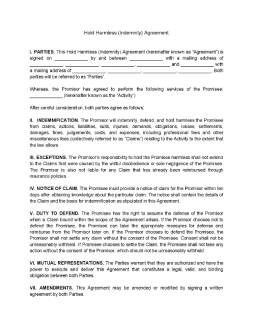- Eviction Notice Forms
- Power of Attorney Forms Forms
- Bill of Sale (Purchase Agreement) Forms
- Lease Agreement Forms
- Rental Application Forms
- Living Will Forms Forms
- Recommendation Letters Forms
- Resignation Letters Forms
- Release of Liability Agreement Forms
- Promissory Note Forms
- LLC Operating Agreement Forms
- Deed of Sale Forms
- Consent Form Forms
- Support Affidavit Forms
- Paternity Affidavit Forms
- Marital Affidavit Forms
- Financial Affidavit Forms
- Residential Affidavit Forms
- Affidavit of Identity Forms
- Affidavit of Title Forms
- Employment Affidavit Forms
- Affidavit of Loss Forms
- Gift Affidavit Forms
- Small Estate Affidavit Forms
- Service Affidavit Forms
- Heirship Affidavit Forms
- Survivorship Affidavit Forms
- Desistance Affidavit Forms
- Discrepancy Affidavit Forms
- Career Assessment - 16+ Examples, Format, Tips, Pdf Forms
- Undertaking Affidavit Forms
- General Affidavit Forms
- Affidavit of Death Forms
Hold Harmless (Indemnity) Agreement Form
Accidents or unforeseen events, especially in the construction industry, can significantly affect all the parties involved. Not only does it affect the projected timeframe of the project; it can also cause a rift between those involved. Discussions about who is accountable for the financial settlement of the accident can be lengthy and troublesome. Signing a hold harmless (indemnity) agreement can avoid these discussions and provide a clear method on how to resolve similar situations. If these agreements are new to you, continue reading this article to gain more knowledge about its importance in various circumstances. Read More
Hold Harmless (Indemnity) Agreement Form
What is a Hold Harmless (Indemnity) Agreement Form?
Hold harmless agreements or documents with hold harmless clauses are common among businesses that offer high-risk activities or services, construction projects, or any activity that possibly pose danger. Through this document, they inform the other party of the possible danger and their stand if in case accidents do happen. As the name of the document suggests, this agreement basically states that they will not hold the other party liable for the risk. Furthermore, it provides the specifics of what the promisor and promisee will do in these situations.
How Do You Create a Hold Harmless (Indemnity) Agreement Form?
As it is commonly used in the construction industry, hold harmless agreements are often used by and between contractors and owners. But aside from constructing new establishments, this agreement is also used in renovation projects among small-time workers. Hold harmless agreements are also used by agencies that offer extreme sports activities, such as sky diving or bungee jumping. Both activities pose possible dangers that are known by both parties involved. If you are about to engage in similar activities, take time to know the inner workings of a hold harmless agreement.
1. Identify the Role of the Parties
Similar to any type of agreement document, a hold harmless agreement starts with the introduction of the parties involved. Aside from the basic details of the parties, such as their legal names and mailing addresses, the introduction clause identifies their roles for the entire arrangement. One party is referred to as the Promisor. This is the individual or corporation that holds the promise to indemnify the Promisee. On the receiving end, the Promisee becomes the recipient of the promised indemnity. The identification of the parties’ respective roles is more important than how it seems. All throughout the document, each party will be referred to as their role to avoid confusion.
2. Describe the Activity Accurately
The next crucial piece of information that the agreement presents is the activity. The nature and specifics of the activity must be detailed using understandable language. Presenting the details for this part may vary according to the nature of the project. For example, construction projects must include the expected timeframe and all the activities necessary. A list of the equipment used can also be included.
3. Indicate the Obligation of the Promisor
After the description of the activity, it is directly followed by the specification of the indemnification. This clause is the general idea of the promisor’s obligation towards the promisee. It states the complete list of what the promisee can claim from the promissory. Clear statements about the promisor’s obligations are critically important for both unilateral and reciprocal types of hold harmless agreements.
4. Highlight the Responsibilities of the Promisee
Following the general use of agreements, it is expected that the promisee also has responsibilities to take care of for the other party. In hold harmless (indemnity) agreements, the responsibility of the promisee under different circumstances are also listed. It especially considers what the promisee should do when the promisor refuses to provide a defense. An example is an article that states that the promisee can demand reimbursement from the promisor after going through the process of claiming the damages themselves. Moreover, the document also states the limits of what both parties can do, especially for the promisee.
5. Understand the Supporting Clauses
The remaining statements of the agreement support the finalization of the arrangement by settling its other aspects. Procedures regarding when to notify for a claim, representations for both parties, and methods regarding amending the arrangement are some of the supporting clauses that create a clean-cut hold harmless agreement. Standard statements for agreements are obviously necessary for this agreement as well. Statements that indicate the governing law, severability, and arrangements regarding assigns and successors should be present as well.
FAQs
What happens when you indemnify someone?
When you indemnify someone, you absolve that person of their responsibility for all the damages and losses from a particular transaction. Basically, it clears the slate of that individual.
How is indemnity different from liability?
Liabilities are tailored for public claims for injuries and damages. On the other hand, indemnity covers the claims done by professional negligence.
What are the three types of hold harmless agreements?
There are three standard types of hold harmless agreements. These are the broad form, intermediate form, and limited form. All these three types are commonly used in the construction industry. Hold harmless agreements are associated with the type of insurance claimed by both parties involved in the project or activity.
What information should the agreement present?
A hold harmless indemnity agreement should have the following vital pieces of information: details of the party that needs to be held harmless, details of the other party providing the protection, the project or activity between the parties, specifics of the protection, and the timeframe.
Do hold harmless agreements need notarization?
No, hold harmless agreements do not require notarization. The signatures of both parties are enough to make the agreement complete and enforceable. However, the parties can choose to notarize the entire document for additional protection.
Security and protection is a basic human need. There are several ways to acquire these and it includes signing a hold harmless agreement. This document provides a sense of security for the promisee who is promised by the promisor. However, there is a limit when it comes to certain construction jobs that can cause irreparable damage. Other than that, hold harmless agreements are important to instill accountability and responsibility for the parties involved.

